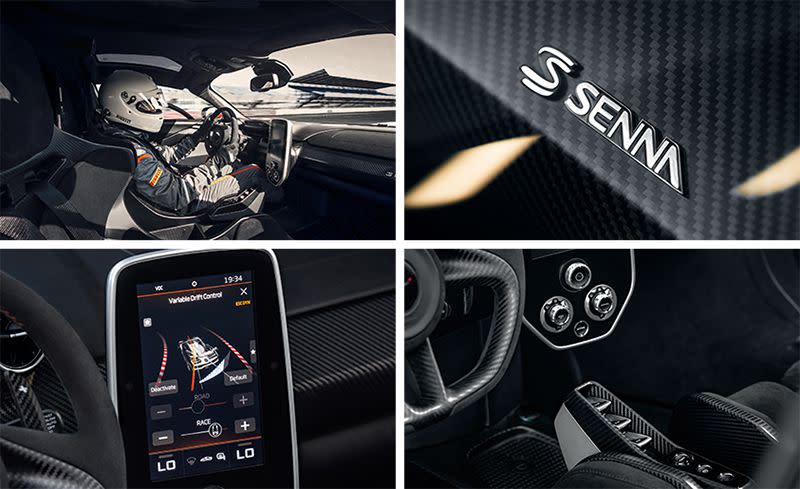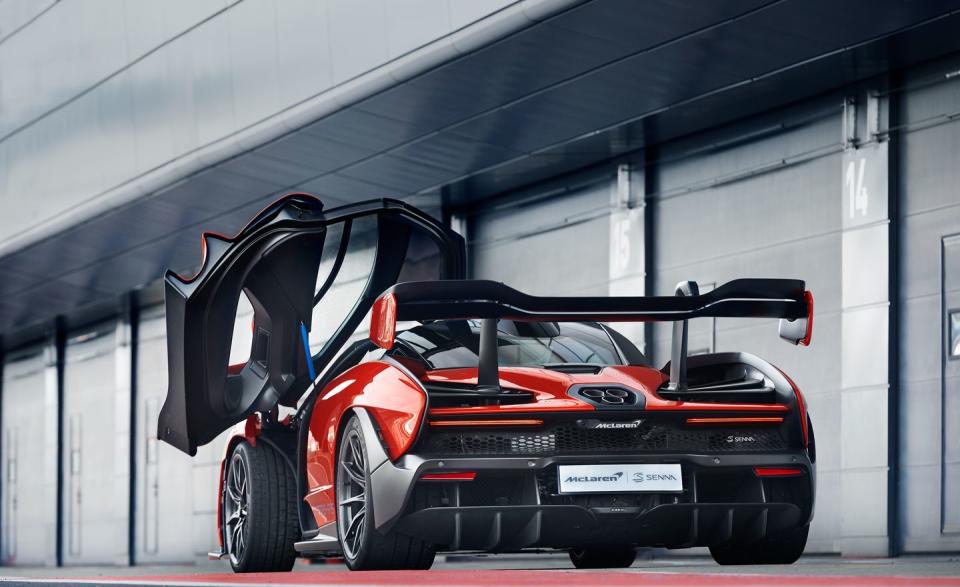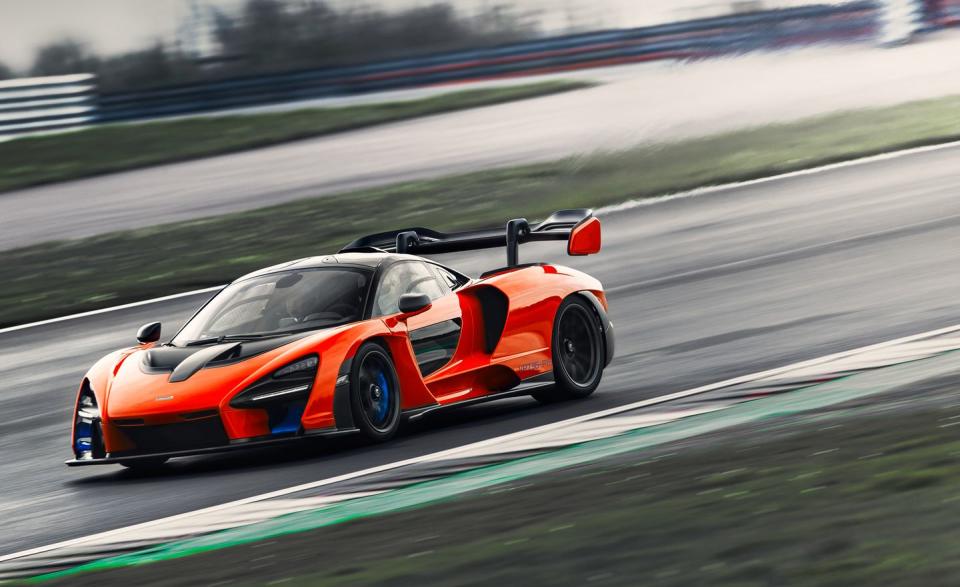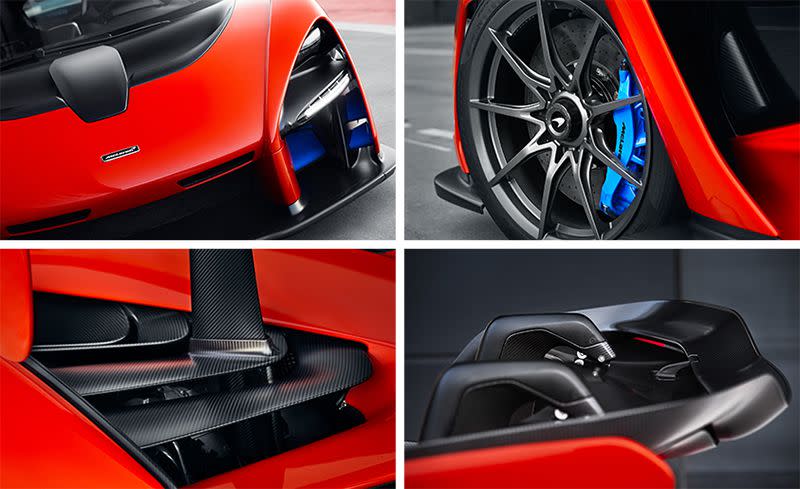We Drive the McLaren Senna: May the Downforce Be with You
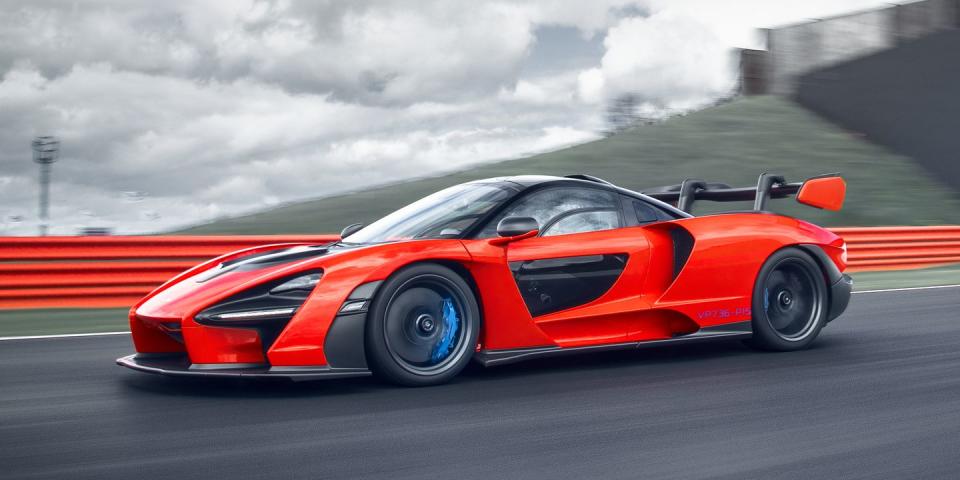
Because a car named the Bruce would need to be powerful like a gorilla yet soft and yielding like a Nerf ball, McLaren’s masterstroke is named not for the company’s founder in the manner of Ferrari’s Enzo but for the Brazilian racer Ayrton Senna, who won each of his three Formula 1 championships while driving for the team Bruce McLaren started.
True to its namesake, the McLaren Senna demonstrates deep focus and bristles with an unrelenting intensity. Molded from carbon fiber and honed in the wind tunnel, it is a 789-hp assault on road courses and the air that inhabits them. It is McLaren’s first car with the gravitas to move the brand beyond the storied F1. And while the Senna is entirely unlike the Ferrari Enzo, the two cars will continue to be mentioned in the same breath as automotive legends named after automotive legends.
In the coming years, McLaren will split its Ultimate Series into a three-pronged assault on the offshore bank accounts of the world’s ultrawealthy. The 903-hp hybrid P1 and its eventual successor trade in bleeding-edge technology. The upcoming three-seater, known for the moment as BP23, will be a grand tourer with a top speed that measures up to (or beyond) the F1’s 240 mph. Then there’s the Senna, the sharpest blade in McLaren’s all-things-to-all-billionaires approach.
Like all McLarens since the 2011 MP4-12C, the Senna is spun from a carbon-fiber chassis, a twin-turbo V-8, and a seven-speed dual-clutch automatic cranking the rear wheels. Compared with that in the 720S, the 4.0-liter V-8 features new camshafts, a higher-flow and more efficient twin fuel-pump setup, a redesigned intake fed by the roof snorkel, and a carbon-fiber intake manifold that weighs just six pounds. Turned up to 789 horsepower-79 more than the 720S-peak power arrives 250 rpm earlier, at 7250 rpm. Its maximum torque of 590 lb-ft (up 22 on the 720S) peaks at 5500 rpm on the way to a 7500-rpm redline. And while it blares a righteous and raw soundtrack in the cabin, the engine can’t compete for trackside bystanders’ ears with the absolute loudness of the air being funneled, over, under, around, and through the car.
A Blade Honed in the Tunnel
Among McLarens, the Senna can’t claim to be the most expensive, nor the most exclusive, nor the most powerful, nor the fastest. But as a purpose-built track car, it lays the deepest roots to the company’s 54-year racing history and distills McLaren’s lightweight and functional design ethos to its purest form. Likely to weigh around 2850 pounds, it is McLaren’s lightest production car since the 2579-pound F1. At 155 mph, 1764 pounds of aerodynamically generated downforce press through the Senna’s rubber and into the tarmac.
The Senna’s brutalist design is the result of styling the car “aerodynamic element by aerodynamic element,” as director of engineering design Dan Parry-Williams puts it. Aerodynamics dominated the discussion to the extent that engineers and designers sparred over one-tenth of an inch of width in the rear fenders. That nuance is largely lost, though, to swollen air ducts, a skyscraping wing, a race-car-worthy rear diffuser, and a front overhang rivaling that of the Lincoln Continental Mark V. But even if it’s obvious that design took a back seat on this one, the Senna’s purposeful shape is as captivating as the company’s more sculptural 720S.
The technical tour continues inside with an open door offering glimpses of the patchwork carbon fiber that forms the Monocage III chassis. Woven, stitched, and sheet-molded sections combine as strength, rigidity, and weight targets demanded. Repositioned for greater leverage, the gas door struts move inside the cabin and shrink to roughly a quarter the size of the 720S’s. Eliminating McLaren’s characteristic door ducts and fitting small ticket windows allowed the company to offer the optional, $3580 glass inserts that enhance the speed-drunk sensation of riding in a Senna. We’re told that 60 percent of Senna buyers have taken the seven-pound penalty they incur for a glimpse of the roads they’ll skim.
The carbon-fiber-shell buckets are customized for each buyer with one of three padding thicknesses. The high shelf behind the driver and passenger-the only cargo storage in the car-is sized for two helmets and two racing suits, and the options list includes a $6710 push-to-drink system. Ancillary switchgear such as the electronic door releases, window switches, and the push-button ignition are relegated to the ceiling, while the transmission selector slides fore and aft with the driver’s seat, so it’s always within reach of a driver who’s locked into position with a six-point harness, a HANS device, and a full-face helmet.
The car that we’re given to drive is VP736-P15, one of 12-or 10, or possibly just nine depending on whom you ask-Senna validation prototypes in existence. No matter how you count it, this particular car is worth far more than the roughly $960,000 starting price for each of the 500 production Sennas. (Every car is already spoken for.) And its duty won’t cease with the end of Senna engineering. VP736-P15 likely will be harvested for parts and repurposed for development of the non-road-legal GTR variant.
Dynamically, this prototype is a finished car. We expect only one noteworthy change when the production cars begin to appear shortly. The swan-neck pylons that grab the wing from the top side have been restyled to reveal more of the hydraulically actuated linkages that continuously adjust the wing’s pitch to increase downforce, trim drag, or stand the wing on its front edge as an air brake. The wing works in tandem with a pair of active airfoils located in the ducts beneath the headlights to keep the axles aerodynamically balanced.
Let’s Track It
Our test track is England’s Silverstone, where in 1988 Ayrton Senna earned his only Grand Prix win in the United Kingdom. The forecast in Towcester (pronounced “toaster,” obviously) calls for sun and temperatures in the 60s, which translates in reality to a blustery 40 degrees with a vaguely bright spot glowing behind a low blanket of dreary clouds. The sky feints rain all day.
After five reconnaissance laps of Silverstone’s 1.9-mile International Circuit in a 720S, we graduate to two six-lap stints in the Senna. As if to goad us into making every one of those laps count, McLaren’s presentation highlights exactly where the Senna outpaces the more powerful P1, and the theme is clear: Carry your speed deeper. Senna drivers can stay in it 82 feet longer down the back straight before braking for the violently fast Stowe corner.
The Senna rides on McLaren’s RaceActive Chassis Control II suspension, an evolution of the P1’s setup that links the dampers laterally and longitudinally to manage both roll and heave. It also drops the car closer to the pavement in Race mode, by 1.5 inches on the front axle and 1.2 inches in the rear. On Silverstone’s smooth tarmac, though, there’s no knowing if the Senna floats over imperfections like the 720S does. Legally, owners can drive the Senna on the road, but any trip that doesn’t end at a road course will only be a tease. In McLaren’s words, the car is “legalised for road use but not sanitised to suit it.”
Parry-Williams acknowledges that the Senna’s extreme capabilities are also its kryptonite. One of McLaren’s greatest challenges was to make this car engaging at the relatively low speeds of road driving, he says. That’s clear even as we learn our way around Silverstone. Below its limits, the Senna could be negotiating Washington D.C.’s Capital Beltway at rush hour for its effortlessness.
At speed, that translates into fluid precision. The standard Pirelli P Zero Trofeo R tires, size 315/30ZR-20 in back, feel as if they could peel the paint from the curbing even without the downforce amplifying their stick. The nose of the car points in on cue, and the steering weights up with the smallest deviation from center.
Assisted by the brake booster from the P1 GTR, the Senna’s left pedal is even stiffer than the 720S’s. It’s as natural as it is reassuring in this environment where there’s no such thing as casual braking. The Senna marks McLaren’s first use of CCM-R brakes, a sort of hybrid between traditional carbon-ceramic rotors and the carbon-carbon units used widely in racing. The discs are baked continuously for months during manufacturing, rewarding patience with greater friction and increased rotor life in track use. It takes a conscious effort to push our braking points far enough down the track to truly test the stoppers.
Trust the Downforce
As high as they are, the Senna’s cornering limits remain within grasp thanks to a delicate mid-engine balance and high-speed poise. There’s a learning curve to commanding this much downforce, though. Grasping the lesson means taking corners with unchallenged confidence, and the test comes twice a lap in the high-speed sweepers at the ends of both straights. Passing pit lane on our last lap, we dab the brake pedal, downshift one gear, and hurry back to the throttle with perfect timing. The Senna arcs gracefully into the right-hander even as its front tires wriggle the steering wheel and the rear end pivots. To fully experience the Senna, you must trust the tires and trust the downforce, but mostly you must trust the driver.
Describing his experience in a Formula 1 car, Ayrton Senna spoke of driving by instinct and unlocking another dimension. We can’t capture such transcendence in our 12-lap tease of the car that wears his surname, but we find ourselves relishing another euphoric high that Senna knew well; the ability to unlock more from the car and more from the driver comes from broaching previously unexplored limits. The Senna breaks through barriers for the McLaren brand as well. With the strict adherence to low weight and functional aerodynamics elevating the Senna to another plane, McLaren has built a car with immense personality. A car that’s worthy of this prized name.
You Might Also Like

 Yahoo Finance
Yahoo Finance 
